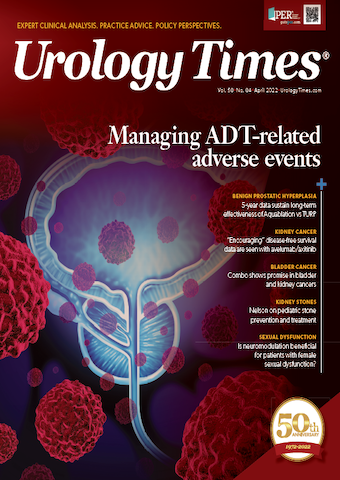Publication
Article
Urology Times Journal
Where can we do better in benign urology?
Author(s):
"Although it might be easier to enumerate the cancer conditions, in the benign world, struggles continue to overcome patients challenged with these conditions," writes Gopal H. Badlani, MD.
Gopal H. Badlani, MD

In my most recent editorial, I recounted the advances we had made in the last 50 years in benign disease.1 It also provided a good opportunity to reflect on conditions or situations for which we must, still, strive to do better. Although it might be easier to enumerate the cancer conditions, in the benign world, struggles continue to overcome patients challenged with these conditions.
Bladder. The underactive or acontractile bladder2 remains an enigma with no pharmacological or surgical solutions. Although we may understand the multiple pathways that cause the bladder to decompensate, such as aging, prolonged stretching, ischemia, or neuropathy, we still do not know how to predict and/or reverse this change. Mechanical drainage remains the standard treatment. Neuromodulation or bladder stimulation have been attempted, but it is not a current therapy. There is no pharmacological intervention. The advance we have made is in naming the condition differently.
The other aspect of bladder dysfunction affecting a smaller portion of the population is Interstitial cystitis. We now understand that it is not a single entity,3 a segment may not be bladder driven; but the clinical ability to make that decision and apply standard treatment is still elusive, despite strong research support from the National Institute of Diabetes and Digestive and Kidney Diseases.
Stones. The evolution of endourology and devices has made the modern management of stones an art form; however, we have not made a significant advance in their prevention or recurrence. Despite guidelines on medical management, such as those from the American Urological Association,4 and improved knowledge of metabolic pathways, there has been no decline in incidence, visits to the emergency department, or the acute pain of renal colic. An increased obesity in the population may be one of causes, but public policy for prevention has been lacking.
Prostate. The ever-increasing options to manage the benign prostate have been a technical marvel; however, in the rearview mirror I see all the ones we abandoned after a few years of enthusiastically embracing them as the next big thing. The concern is that we did not learn from the mistakes and continue to accept new treatment options without waiting for durable success. Heating the prostate with low-energy or high-energy microwave; focusing the interstitial laser or radiofrequency current on it; injecting it with agents or dilating it with balloon or stents; and waving certain lasers at it are all in “rest in peace” mode. Yet we are enthusiastically heating, placing devices, or using new lasers, each method promising to let us have our cake and eat it too. Thanks to various investigators and guidelines that have restrained the blaming of the prostate in every older man who complains about getting up at night.5
Reconstructive urology. Despite the advances in tissue engineering and cell therapy, reconstructive urology still relies on the host for providing the graft for replacement or augmentation. The morbidity of harvesting bowel, skin, fascia, muscle, or mucosal flaps remains a challenge to conquer. Off-the-shelf material has made female and male incontinence surgery a new paradigm, but the genitourinary Reconstructive Surgeons, despite advances in surgical techniques, cannot take advantage of minimally invasive surgical techniques due to a lack of constructs.
Urinary tract infection (UTI). Recurrent UTIs in women continue to fill the schedules at urology clinics. A variety of techniques and rituals has failed to conquer this challenge. The advance in genetic testing for urinary pathogens has led to a decrease in the time to identify the organism responsible. A recent report of a vaccine6 may be groundbreaking if the study results can be replicated in the general population. The ever-growing number of pathogens that are resistant to available antibiotics are a potential threat, as no newer antibiotics class is on the horizon.
I am fortunate to see and review many new research applications to conquer these challenges. The hope is that we see improving quality of life as important as correcting an anatomical defect or curing cancer.
“Energy and persistence conquer all things” – Benjamin Franklin.
References
1. Badlani GH. Golden jubilee: looking back at 50 years of urology in benign diseases. Urology Times®. January 27, 2022. Accessed March 14, 2022. https://www.urologytimes.com/view/golden-jubilee-looking-back-at-50-years-of-urology-in-benign-diseases
2. Colaco M, Osman NI, Karakeçi A, Artibani W, Andersson KE, Badlani GH. Current concepts of the acontractile bladder. BJU Int. 2018;122(2):195-202. doi:10.1111/bju.14236
3. Overholt T, Evans RJ, Badlani G, Matthews CA, Walker SJ. Functional genomic analyses of IC/BPS patient subgroups: a pilot study. Can J Urol. 2022;29(1):11012-11019.
4. Pearle MS, Goldfarb DS, Assimos DG, et al; American Urological Association. Medical management of kidney stones: AUA guideline. J Urol. 2014;192(2):316-324. doi:10.1016/j.juro.2014.05.006
5. Soloway MS, Weiss JF, Wien AJ. Nocturia. Curr Urol Rep. 2016;17(10):77. doi:10.1007/s11934-016-0632-0
6. Nickel JC, Saz-Leal P, Doiron RC. Could sublingual vaccination be a viable option for the prevention of recurrent urinary tract infection in Canada? A systematic review of the current literature and plans for the future. Can Urol Assoc J. 2020;14(8):281-287. doi:10.5489/cuaj.6690





























